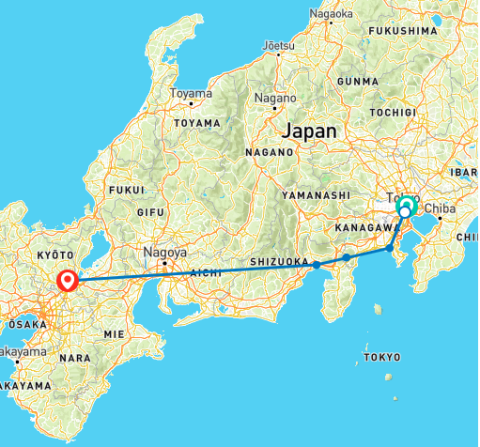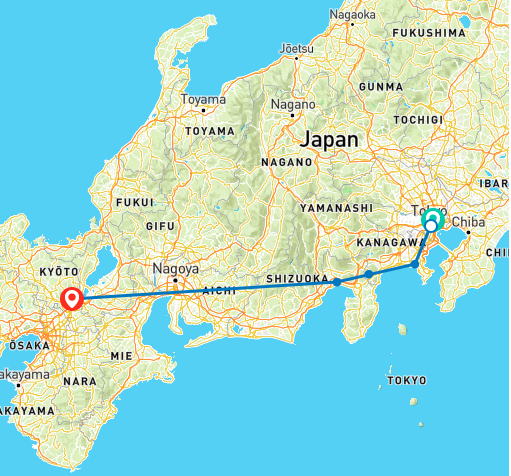
// Xiaopo Island has something to say:
///
NOTICE
Did your trip to Japan in the post-epidemic era make you feel a little confused and overwhelmed? How to choose a "group tour" and how to have a better time? ! In today’s issue, the editor has chosen two classic and interesting Japanese group travel routes for you. can balance free time and group activity time well . Let’s take a look!
1. The best eight-day tour in Japan

Source: Tourradar official website
The best 8-day tour route in Japan starts from Tokyo , passes through Kamakura, Hakone , and finally ends in Kyoto . The group can accommodate up to 24 people and will stay in a three-star hotel for for 6 nights and experience a traditional Japanese inn for 1 night . In addition, it also includes professional tour guides to explain the entire scenic spot, catering, pick-up and transportation and other services .
Day1-Day4

Source: Wikipedia
After arriving in Tokyo, tourists will be picked up by relevant tour guides at Narita or Haneda Airport. After checking into the hotel on the first day they will be able to have free activities in downtown Tokyo.
The next day, explore the capital. The tour guide will take visitors to experience Japan by subway, heading to Asakusa to visit the lively Sensoji district, home to Tokyo's first temple and many interesting souvenir and craft stalls. In the afternoon, we'll head to Harajuku, home to many trendy shops and cafes that attract young and trendy Tokyoites.
The final stop of the day was Shibuya Crossing - considered one of the busiest intersections in the world. The famous intersection has no less than seven crosswalks, and when the traffic light turns red, a wave of pedestrians, as many as 1,000 people, converge on the intersection from all directions. Known as "The Scramble," it's a skilled art of dodging and weaving with the agility of an athlete to avoid collisions, and visitors will watch from the second floor of the Starbucks located directly across from the intersection.

Source: Wikipedia
On the third day , the itinerary is Tokyo-Kamakura-Tokyo . In the morning, visitors will board a train to Kamakura, Japan's first feudal capital , just an hour's drive from Tokyo. Kamakura is a popular seaside location with quaint country life and some stunning Zen temples. Here, visitors will visit the iconic Bronze Buddha and the French Temple Zen Temple with its beautiful bamboo garden. In the meantime, drink tea and learn about the tea ceremony before strolling through the cobbled shopping area.

Source: Wikipedia
On the fourth day, visitors will go to the Tokyo Edo Museum for sightseeing, where the focus will be on Tokyo’s 400-year historyTokyo people’s lifestyle and culture. The museum houses some of the city's finest collections of original artifacts and replicas of Edo period buildings and landmarks, as well as several large-scale models. The remainder of your visit to the museum provides free time for independent exploration.
Day5

Source: Wikipedia
On the morning of the fifth day , tourists will take a highway bus (with luggage transfer) to Lake Kawaguchi located at the foot of Fuji-Hakone Izu National Park Mount Fuji. The panoramic views of snow-capped Fuji are breathtaking and can be enjoyed most of the year. Upon arrival, visitors will travel along the Mount Fuji Panoramic Ropeway and visit the Observatory . For a trip that stays at Lake Kawaguchi from April 15 to May 28 every year, we will visit the Spring Fuji Shibazakura (Phlox) held at Lake Motosu , where the landscape is covered in vibrant pink moss, with Fuji as a backdrop, the view is spectacular and unforgettable.
Day6-Day8

Source: Wikipedia
On the sixth day , tourists will take a bus to Mishima and then take a bullet train to Japan's ancient cultural capital Kyoto . One of Asia's most culturally rich cities, Kyoto is home to a number of UNESCO World Heritage Sites, Buddhist temples and shrines . Here we will enjoy a guided tour of Sanjusangen-do Temple, which is famous for its statue of Guanyin Bodhisattva. One thousand life-size statues of Guanyin are made of Japanese cypress wood wrapped in gold leaf. They are arranged in 10 rows of 50, each row is handmade and slightly different from the next.

Source: Wikipedia
On day seven , visitors will take a guided tour to Nijo Castle , one of the city's most impressive UNESCO sites. The exquisite Nijo Castle, built in 1603 by the first Tokugawa shogun, is a fine example of Momoyama architecture.
Afterwards, we visit Kinkaku-ji (Golden Pavilion) , a stunning Zen Buddhist temple and part of the World Heritage Historic Site of Ancient Kyoto. The top two floors of the monument are completely covered in gold leaf and sit on a small lake with landscaped gardens. This large, fully gilded building is as impressive as it is a beautiful temple.
There is free time in the afternoon for visitors to relax or further explore Kyoto's many attractions on their own terms. Consider visiting Fushimi Inari Shrine, known for its winding roads lined with thousands of bright red torii gates. Visitors can also rent kimonos to walk the streets, as many Japanese do Take, or take a cooking class.
Day 8, our trip ends after checking out of the hotel!
2.Japanese food culture 6-day tour route

Source: Tourradar official website
Kyoto, Osaka, Nara Japanese food culture 6-day tour , Up to 12 people can register to participate . This tourist route starts from Kyoto and ends with Osaka. Accommodation standard is three-star hotel accommodation per night, Kyoto is
HOTEL RESOL KYOTO SHIJO MUROMACHI or similar; in Osaka, Hotel Vista Osaka-namba or similar . Also included are two hiking tours , a Japanese cooking class and three minivan tours .
Day1-Day2

Source: Wikipedia
On the first day , check into Kyoto hotel lobby. After gathering, you will walk to the cooking studio for a welcome cooking class dinner. Izakaya style cooking classes are a great way for visitors to immerse themselves in Japanese food culture and learn about authentic and popular Japanese foods to eat at home and in local restaurants.
The next day, meet the tour leader at 9:00 a.m. in the hotel lobby. Enjoy a full-day walking tour visiting four of Kyoto's most popular attractions, including Nijo Castle, Nishiki Market, Gion, Yasaka Shrine and Fushimi Inari Shrine . Led by our knowledgeable tour guides, you'll not only see but experience Kyoto's history and life.
Day3

Source: Wikipedia
Day 3, 9am Meet your driver guide at your hotel and head out for a full day tour. Visit some of Kyoto's top places in the comfort of a minivan today. These include visiting World Heritage Kiyomizu Temple , taking photos at the gate of the large torii gate of Heian Shrine , learning about the history of Japan at Imperial Palace and World Heritage Zen Temple Tenryuji Temple Stroll through the Japanese Garden .
Day 4

Image subscript template, source: Wikipedia
On the fourth day , travelers will take a train south for 1 hour and visit Japan's ancient capital Nara . Spend 4 to 5 hours visiting some of Nara's top venues and feeding wild deer. In addition to feeding deer, it also includes seeing the Big Buddha at Todaiji Temple, visiting Kasuga Taisha Shrine and walking through Naramachi Street. After lunch, you can start to slowly return to Kyoto.

Image subscript template, source: Wikipedia
Day 5 , tourists will take a private car 2 hours arrive North of Kyoto to Amanohashidate and Ine Activities here include strolling through Across the mouth of Miyazu Bay of Pine Sandbar Amanohashidate ,walk Ine Boat House and the surrounding quiet villages, take a boat ride 30 minutes and have a fresh seafood lunch.
Day6

Source: Wikipedia
Day 6 ,bid farewell Kyoto , take a luxury car 1 hour Go Osaka Visitors will spend a full day visiting Osaka The two most popular venues . Must be in Namba and Dotonbori Area Try some of Osaka's signature street food ( Kushiyaki, Doteyaki or Takoyaki ). Dotonbori Along the canal from Dotonbori Bridge To the city center Namba area The activities also include visiting Osaka Castle and stroll through the vibrant Namba and Dotonbori Area If time permits, you can visit the Eiffel Tower in Paris. Tsutenkaku Tower built in 1912 .
The above are the recommended Japanese group travel routes for this issue. If you want to find out more group travel routes, you can log in to the Tourrader official website !
